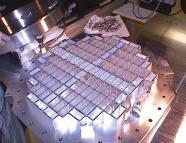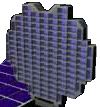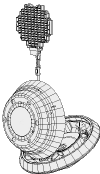|
Dust Collectors
Collection of cometary particle samples is accomplished simply by exposing
blocks of aerogel to the sample flux during spaceflight.

Aerogel Collector |
|---|
 The dust collector media consists of blocks of 1 and 3 cm thick underdense,
microporous silica aerogel mounted in modular
aluminum cells. This is similar to what was used for previous exposures on
Spacehab, Shuttle and MIR experiments.
For the STARDUST mission, cells will be
mounted on both sides of a two-sided, grid-shaped array that will deploy from
the Sample Return Capsule (SRC). After exposure, the cells assembly will fold
up to a compact configuration for stowage into the Earth return capsule.
The dust collector media consists of blocks of 1 and 3 cm thick underdense,
microporous silica aerogel mounted in modular
aluminum cells. This is similar to what was used for previous exposures on
Spacehab, Shuttle and MIR experiments.
For the STARDUST mission, cells will be
mounted on both sides of a two-sided, grid-shaped array that will deploy from
the Sample Return Capsule (SRC). After exposure, the cells assembly will fold
up to a compact configuration for stowage into the Earth return capsule.
 One side of the modules will be used to collect samples during the comet
encounter and the opposite side will be used for interstellar collection. The
useful collecting area is 1000 cm2 for
interstellar dust grains and 1000 cm2 for
cometary dust.
Graded density media will be used to give even lower density for the initial
impact. These collectors are totally inert and only have to be exposed and
then recovered.
One side of the modules will be used to collect samples during the comet
encounter and the opposite side will be used for interstellar collection. The
useful collecting area is 1000 cm2 for
interstellar dust grains and 1000 cm2 for
cometary dust.
Graded density media will be used to give even lower density for the initial
impact. These collectors are totally inert and only have to be exposed and
then recovered.
The Sample Return Capsule is about a meter in diameter, and is shown here open
like a clamshell with the dust collector grid deployed into the dust stream.
|

